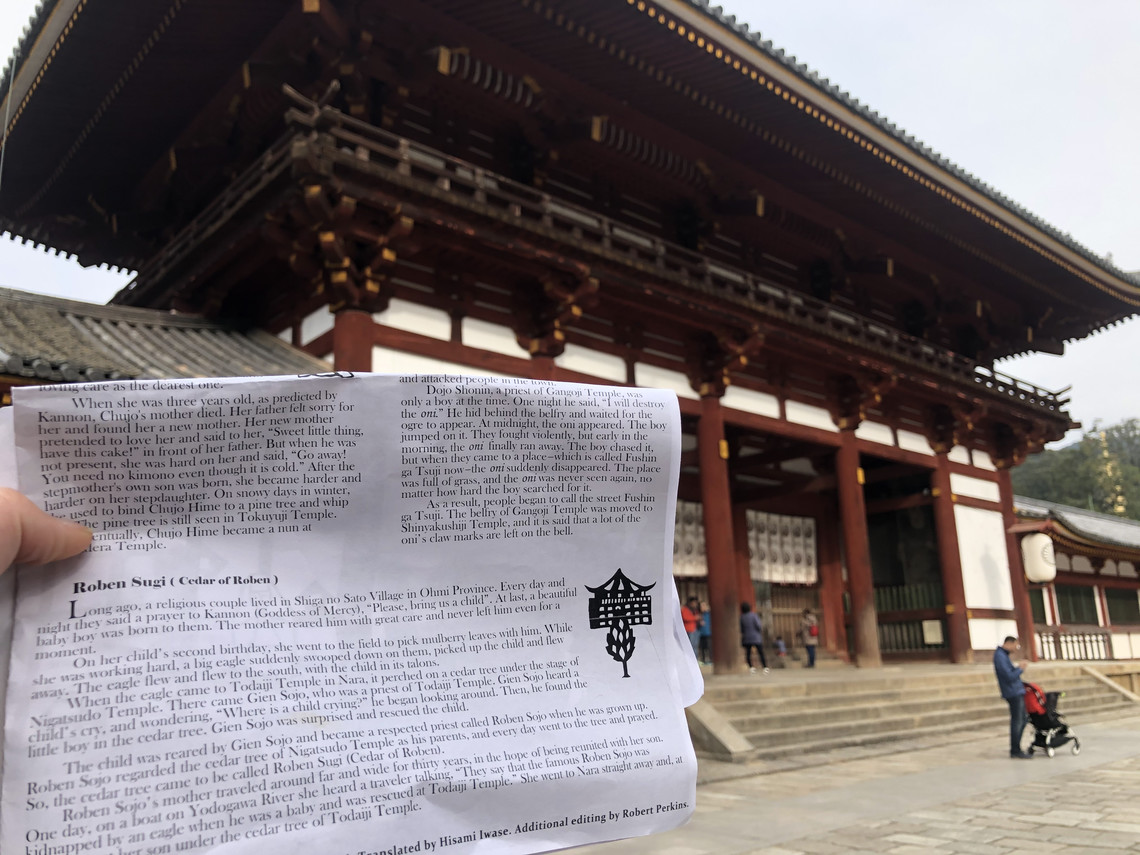Morna's third week in Japan takes her to Hiroshima and Naoshima, an island in the Seto Inland Sea. She delves deeper into Japan's folklore, finding interesting ties to our traditions here and shares traditional Scottish songs in a Japanese pub.
[5 minute read]

I return to Kyoto, still minus voice, and I dive straight into interviewing folklore academics including Professor Uno, a PHD alumni from Edinburgh University, who sings Scottish and Japanese lullabies for me over lunch. It is a joyous experience, though I wish I could return the gift of song.
This flurry into musical tradition marks the beginning of a theatrical weekend where I watch four hours of Noh Theatre (the oldest surviving form of Japanese theatre) plus a contemporary dance piece. Seeing full musical troupes on stage lifts my spirits and I try to follow the rhythms of the drums and let the music lead me through the narrative.
From the sound of traditional Japanese to the sound of traditional Celtic, I venture to a session full of jigs and reels in an Irish style pub. I’m interested in the popularity of Celtic culture in Japan and I am fascinated by the incredible musical knowledge of the fiddle and accordion players I meet. After a brief chat with the barman, I find myself handed a violin to join in with the tunes. I always miss playing my instruments when I’m away from home and it’s wonderful to briefly feel part of a musical collective. Language doesn’t matter when there’s a session on the go.

The week ahead brings more travel. Though I have specific research aims, I’m keen to build my knowledge of Japan’s history and I grab the chance to visit Hiroshima, the city that was largely destroyed by an atomic bomb during World War II. I know it will be a difficult visit but I don’t expect it to hit me quite so hard. My reaction to the first sight, the Atomic Bomb Dome structure, takes me by surprise and I can’t stop myself sobbing. The bomb explored almost directly above the structure and the skeleton roof is a haunting sight. As I walk through the Peace Memorial Park and the Memorial Museum, I think about the dawn of atomic warfare and whether we have truly learned any lessons from our not so distant past. Each sight in the park is affecting but I pause the longest at the Flame of Peace which is set to burn until all the world’s nuclear weapons are destroyed.
I think about Hiroshima long after I leave the city and I know the experience will stay with me. Later in the week, I travel onward to Naoshima, an island in the Seto Inland Sea, known for its modern art museums, architecture and sculptures. I’ve read a lot about the decentralisation movement in Japan, to counter depopulation, and Naoshima is one of the arts hubs that’s increasingly gaining popularity. I stay overnight in a ryokan, a traditional Japanese inn, and rise early to walk the island. After visiting the more commercial Benesse art sight, I continue to Honmura in the northern part of the island to explore the Art House Project, a collection of abandoned houses and workshops (as well as a temple and a shrine), that have been converted into art installations. Following a map, I find each of the seven sights and I revel in the childlike joy of such a treasure hunt.

I find myself armed with another map back on the mainland when I visit to Nara, Japan’s first permanent capital. This map, a gift from Professor Uno, contains folklore stories related to the place. Upon finding every destination, I read the related story and it is a magical way to spend a day.
I return to Kyoto once more, tired but with a full heart. Japan has awoken a sense of wonder within me that I didn’t even realise I was missing and I really hope that I can capture this within my writing. There’s something so utterly captivating about the culture, landscape and people and I’m only scratching the surface of possibility. There’s so much to see and to do and my time is running short. A month seems like such a long time but now I desperately wish I could pause here a little longer.
For now, I marvel at the experiences I’ve had with a deep gratitude whilst dreaming about the coming days. I also realise, with gratitude, that my absent voice has returned and I attend another session where I sing traditional Scottish songs in a Japanese pub. Like much of my trip, it is a beautiful clash of cultures.
This residency is supported by the British Council Scotland and Creative Scotland partnership to take part in the British Council’s UK in Japan Season 2019-20. This project is additionally made possible through support from The Great Britain Sasakawa Foundation.

